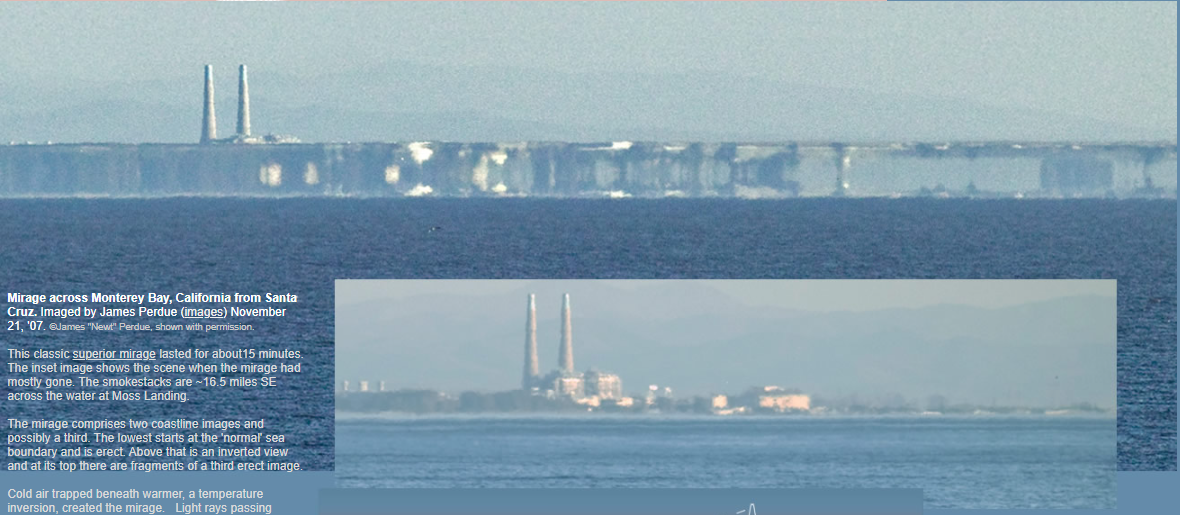Santa Cruz Superior Mirage
Santa Cruz Superior Mirage: A Mesmerizing Optical Phenomenon
When it comes to atmospheric optics, the Santa Cruz Superior Mirage stands out as a captivating example of this natural phenomenon. Captured in stunning images by James Perdue on November 21, '07, this classic superior mirage lasted for approximately 15 minutes. The mirage, observed across Monterey Bay in California, showcased two distinct coastline images, with the possibility of a third faintly visible. Let's delve into the intricacies of this mesmerizing optical illusion and understand the science behind its occurrence.
At the heart of the Santa Cruz Superior Mirage lies a temperature inversion, where a layer of cold air becomes trapped beneath warmer air. This inversion creates the perfect conditions for the mirage to manifest. As light rays pass through the slightly upward path between the denser, colder air and the upper warmer air, they undergo refraction, causing their paths to curve and become concave to the horizon. This downward curvature of the rays is most pronounced where there is a significant vertical temperature gradient.
The mirage's complex structure becomes apparent when examining the diagram provided. The ray labeled 'b' represents light from a ship's mast, which is slightly curved due to refraction. This curvature causes the mast to appear higher than its actual position. Ray 'c', originating from the hull of the ship, encounters an even greater temperature gradient and undergoes stronger refraction. As a result, an inverted image of the ship forms above the lower one, creating an upside-down ship sailing above its real counterpart.
In certain instances, when the inversion layer is thick enough, rays from the mast can take a third route labeled 'd' through the upper warmer air towards the observer's eye or camera. These rays form a third image, this time right-side up. This fascinating interplay between temperature gradients and refraction gives rise to the Santa Cruz Superior Mirage's distinctive characteristics.
It is important to note that the Santa Cruz Superior Mirage is a milder example of a superior mirage. A more extreme version of this phenomenon is known as the Fata Morgana, which exhibits even greater distortions and complex mirage structures. The Santa Cruz Mirage serves as a captivating reminder of the diverse and awe-inspiring atmospheric phenomena that can occur in our natural world.
In conclusion, the Santa Cruz Superior Mirage showcases the remarkable effects of temperature inversions and refraction on light rays. This captivating optical phenomenon creates multiple images of coastal features, with some appearing inverted and others erect. By understanding the science behind this mirage, we can appreciate the intricate interplay between air temperatures and the bending of light. The Santa Cruz Superior Mirage serves as a testament to the mesmerizing beauty and complexity of atmospheric optics.


Mirage across Monterey Bay, California from Santa Cruz. Imaged by James Perdue (images) November 21, '07. ©James "Newt" Perdue, shown with permission.
This classic superior mirage lasted for about15 minutes. The inset image shows the scene when the mirage had mostly gone. The smokestacks are ~16.5 miles SE across the water at Moss Landing.
The mirage comprises two coastline images and possibly a third. The lowest starts at the 'normal' sea boundary and is erect. Above that is an inverted view and at its top there are fragments of a third erect image.
Cold air trapped beneath warmer, a temperature inversion, created the mirage. Light rays passing slightly upwards between the dense colder air and the upper warm air are refracted so that ray paths become curved and concave to the horizon level. I.e. they tend to curve downward. The ray curvature is strongest where the vertical temperature gradient is greatest.
In the diagram, the ray 'b' from a ship's mast is slightly curved making it mast appear to be at a point above the 'real' ship. Ray 'c' from the hull encounters a higher region of even greater temperature gradient and is more strongly refracted. Where ray crossing occurs the resulting image is inverted - an upside down ship sails above the lower one. When the inversion layer is thick enough, rays from the mast have a third route 'd' through upper warmer air towards the eye or camera. They form a third image - this time the right way up. The Fata Morgana is a more extreme superior mirage.
Note: this article has been automatically converted from the old site and may not appear as intended. You can find the original article here.
Reference Atmospheric Optics
If you use any of the definitions, information, or data presented on Atmospheric Optics, please copy the link or reference below to properly credit us as the reference source. Thank you!
-
<a href="https://atoptics.co.uk/blog/santa-cruz-superior-mirage/">Santa Cruz Superior Mirage</a>
-
"Santa Cruz Superior Mirage". Atmospheric Optics. Accessed on December 22, 2024. https://atoptics.co.uk/blog/santa-cruz-superior-mirage/.
-
"Santa Cruz Superior Mirage". Atmospheric Optics, https://atoptics.co.uk/blog/santa-cruz-superior-mirage/. Accessed 22 December, 2024
-
Santa Cruz Superior Mirage. Atmospheric Optics. Retrieved from https://atoptics.co.uk/blog/santa-cruz-superior-mirage/.